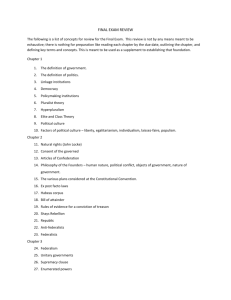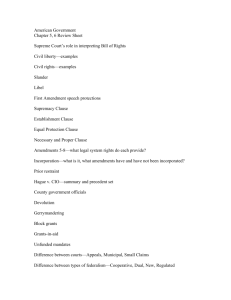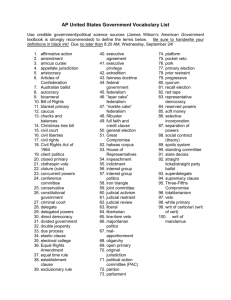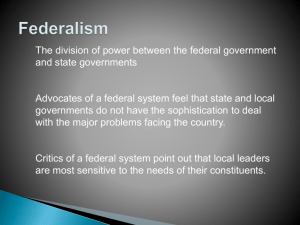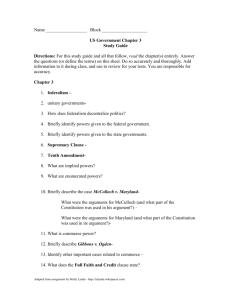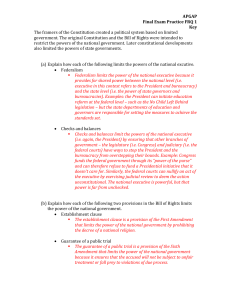APGvfinalexamreviewfallsemester
advertisement
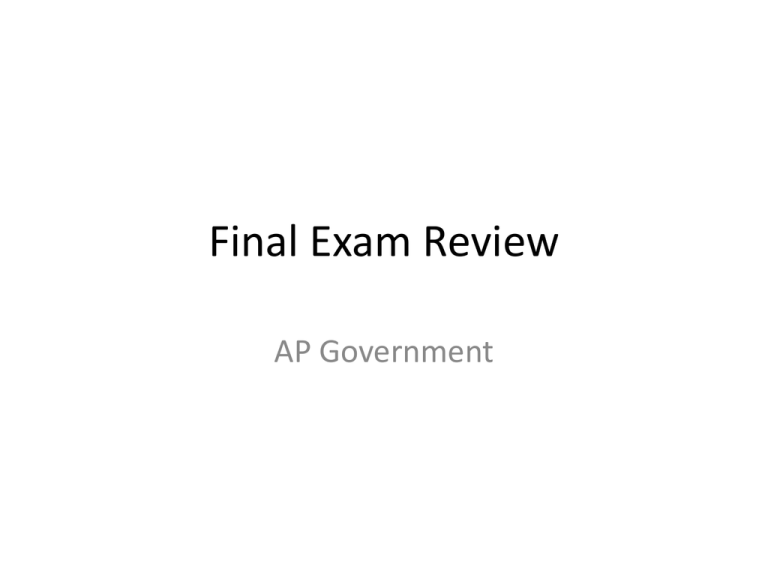
Final Exam Review AP Government Unit 1 Theory & foundation Chapters 1, 2 Unit 1 • 4 characteristics of state: – – – – Population Borders Sovereignty Government • 4 theories on government: – – – – Divine right Evolutionary Force theory Social contract theory Unit 1 cont… • 4 main purposes of government: – Maintain order – Provide public services – Make economic decisions – Providing national security • 3 types of government: – Autocracy – Oligarchy – Democracy Unit 1 cont… • 3 systems of government: – Unitary – Federal – Confederacy Unit 1 cont.… • Early influences on Am. Govt.: – – – – – Greeks! Romans Magna Carta Glorious revolution English bill of rights • Enlightenment & 3 philosophers: – John Locke – Jean Rousseau – Baron De Montiseque Unit 1 Cont… • Path to the Const. – – – – – Early good relations turned sour King George takes throne & England in debt Series of acts/taxes placed on colonies Colonies rebel form first & second Cont. Congress Declaration of independence & common sense written – US wins war, moves from 2nd continental congress to Articles of Confederation – Articles weaknesses makes call for constitutional convention Unit 1 cont… • Path to Constitution cont.: – – – – Meet Philadelphia PA Virginia plan proposed Countered with New Jersey plan Stalemate leads to Connecticut/sherman/great compromise – 3/5th Compromise struck to settle representation & taxation in the south – Slave trade/Commerce compromise – Electoral college & presidential term length compromise Unit 2 US Constitution Chapters 3, 4 Unit 2 • 3 parts of US Constitution: – Preamble: – Articles 1-7 – 27 amendments • 6 principles of US Constitution: – – – – – – Popular sovereignty Federalism Judicial review Checks & balances Separation of powers Limited government Unit 2 • 7 Articles: – 1. Legislative Branch: makes laws – 2. Executive Branch: executes laws – 3. Judicial branch: interprets laws – 4. Relations among the states: full faith & credit, Extradition clause, immunities & privileges Clause – 5. How to amend Constitution: formal ways – 6. Supremacy Clause: highest law of land – 7. Ratification: proof this government legit Unit 2 cont… • Amendment process: – Proposed: • 2/3 of both houses of congress • National convention at request of 2/3 of states – Ratified: • ¾ of state legislatures • By ¾ of states in state conventions – Informal ways: • Court rulings • Passing laws • Governing the country and addressing its needs Unit 2 cont… • 1st amendment: speech, press, petition, assembly, religion – Know court cases creating limits or lifting them • 2nd: right to bear arms, militia or people • 3rd: quartering of troops, times of war vs. peace • 4th: illegal searches & seizures – Know sup. Ct. cases; exclusionary rule Unit 2: cont… • 5th: grand jury clause, double jeopardy, due process, eminent domain, self-incrimination (Miranda rights) – Know sup. Ct. cases • 6th: speedy public trial, witnesses for, witnesses against, lawyer, nature & cause of accusation • 7th: civil suits above $20 ($75,000), jury trial • 8th: no ex. Bail, ex. Fines, cruel & unusual punishment Unit 2 cont… • 9th: power reserved for the people • 10th: power reserved for the states, or people (root of federalism) • 13th: end to slavery • 14th: equal rights, incorporation doctrine (BOR applied to states), citizenship for former slaves • 15th: right to vote on basis of color or previous servitude Unit 2 cont… • 16th: income tax • 17th: senators picked by people & not state legislatures • 19th: women's right to vote • 22nd: limiting presidential terms, with max. time • 24th: end to poll tax • 25th: presidential disability, VP vacancy • 26th: 18 year olds right to vote • 27th: congressional pay raise Units 3 Federalism Chapter 3 Unit 3 • Federalism: system of government where power is divided between National, state/local • Difference: unitary one national government making decisions, Confederacy is a loose union of independent states come together for limited purpose • National vs. state: look over Venn diagram with powers for each, with some in middle they share Unit 3 cont… • Supremacy Clause: states when federal & state laws at conflict Federal will prevail due to US Constitution • National govt. has become more powerful than states due to: – – – – – Implied powers/necessary & proper clause Commerce power General welfare Supremacy clause Equal protection clause • Obligations to each other Article IV: – Full faith & credit clause – Extradition – Privileges & immunities clause • 10th Amendment: Federalism root Unit 3 cont…. • Types of federalism & eras: – Dual: when each their own mostly clear cut areas (layered cake) beginning to Great Depression – Cooperative: powers & policy shared between the two levels (marble cake) Great depression to now • It involves: – Shared costs – Federal guidelines – Shared administration Unit 3: cont… • Fiscal Federalism: (1970s on) the main relationship of the levels; pattern of spending, taxing & providing grants in the Federal system: – Federal aid (Grant system): • *Categorical grants: (main source) of federal aid to states, very strict, only used for specific categories set aside by national; comes with strings attached of federal guidelines (non-discrimination provision) – Cross over sanctions: money in one program to influence & state & local policy in another program – Cross-cutting requirements: one federal grant condition extended to all activities supported by federal funds Unit 3: cont… • Federal aid (Grant system) cont.: – 2 types of categorical grants: • 1. Project grant: most common, granted on basis of competitive application (National Science grants given to college professors) • 2. formula grant: the portion of funds you get is based on a strict formula that congress has created; not applied for by state, all states receive some based on formula (ex. Medicaid, child nutrition programs) Unit 3: cont… • Federal aid cont: – Block grants: to ease the burden & lengthy process; given automatically to states with discretionary power by state to decide how to spend – An attempt to return power under federalism back to states decide some of the matters within own border (Devolution) Unit 3 Cont… • New Federalism (1980s to early 2000s): – Started with election of Ronald Reagan and really went into effect in 1990s when Republicans took control of Congress (1990s) for first time since prior to Depression – Conservatives being fans of state & local governments (anti-federalists), began giving more decision making and enforcement powers back to states (Devolution) – They also used more Block grants in giving states more power to decide how to spend money Unit 3: cont… • Advantages of federalism: – A. More opportunities for citizen participation in government due to layers – B. Greater citizen access to government – C. Differences of opinion can be reflected in different policies in different states – D. Reduces decision-making at federal level, which could be overwhelming Unit 3: cont… • Disadvantages of federalism: – A. Resources are not distributed evenly, resulting in different quality of services (education, welfare, etc.) – B. Local interests can sometimes thwart national interests (ex.: civil rights) – C. Too many levels of government can be costly and inefficient – Can lead to voter fatigue. (app. 87,000 government entities) Court Cases • • • • • • • • • • Don’t forget to look over your Federalism Court cases. Maryland v. McCulloch: implied powers Gibbons v Ogden: Commerce Clause Heart of Atl. Motel v. US: Commerce Clause South Dakota v Dole: General Welfare Clause Puerto Rico v Branstad: Extradition Clause US v Lopez: reversal of Commerce Clause Gonzalez v Raich: Commerce Clause (national market) Gonzalez v Oregon: Reserved powers used to push back Windsor v US: 10th amendment & equal protection clause Unit 4 Public Opinion, Elections, Voting Chapters 6, 9 Unit 4 • Due to large population, diversity & lack of knowledge people’s preference for policy hard to reach • US on path to minority majority • • • • Largest group African Americans Latinos predicted to pass/be #1 by early 21st century Asian Americans the most skilled & best off group Native Americans, the worst of group, least healthy, poorest & least educated! • However, we still share a lot we call our political culture Unit 4 cont… • How do we acquire our political socialization? – Family – Media – School • Most of our learning more informal than formal • How is our political socialization measured? – Public opinion polls (Gallup) • • • • Sample population (1500) Random sampling Sampling error Most of it done through digital dialing today Unit 4 cont… • Pros & cons of polling: – supporters: tool for democracy, keep up w/changing opinions on policy – critics: it distorts election process: bandwagon effect; east coast vs. west coast; manipulation through wording • Political participation consensus: – Little more conservative than liberal, but changing due to minority majority – Conservative/liberal decided by age, race, gender, socioeconomic status – Women not so much minority but suffer from gender gap Unit 4 cont… • Political participation: many activities used by citizens to influence the selection of political leaders or the policies they pursue: – 1. United States has a participatory political culture: • a. 51-60% participate in Presidential elections • b. 39% participate in mid-term elections (off-year) • c. Local election turn outs usually 20%-30% • Two types of political participation: – 1. Conventional: widely accepted modes of influencing government: • a. voting, persuading others, ringing doorbells, running for office – 2. Unconventional: dramatic activities: • a. protesting, civil disobedience, and even violence Unit 4 cont… • Political participation a class-biased activity w/citizens of higher socioeconomic status participating more: – 1. differences decline when income & education kept equal, minorities actually participate more – 2. we want smaller government but more services, therefore we are coined as “ideological conservatives” & “operational liberals” Unit 4 cont… • 8 Phases of electing President & VP: Nov. 2014 to Nov. 2016: – 1. Exploratory & announcement (ton of traveling speeches, fundraisers) – 2. Primaries & Caucuses (closed vs. open vs. semi) – 3. DNC & RNC – 4. Face off – 5. General election: popular vote – 6. General election: electoral college votes – 7. Congress certifies election – 8. Inauguration Unit 4: cont… • Remember the evolution of voting: – Male landowners 15th Amend. All males 19th amend. All women & men over 21 24th amend. No poll tax; civil rights act of 1965 no literacy test 26th amend. All 18 year old and up – Exception: felons & non-citizens Unit 4: cont… • Why do we vote? – Believe one party can do it better than other – High sense of political efficacy: their civic duty • How do we vote? – We must register first, to prevent voter fraud and only vote first • Why we have low voter turn out? – Different voter registration rules – Voting too frequently due to federalism – Hardly any difference between candidates • Solution: Voter Motor Act Unit 4: cont… • Profile of voter vs. nonvoter: – Voter: • • • • • • Higher educated Older on average Female White Married, kids Possible union member/govt. employee – Non-voter: • • • • • • Low education Younger Minority Man Single Non-union member/govt. employee Unit 4: Cont… • 3 elements of a voter’s decision: – Party ID: strongest predictor of how people vote! – Voters evaluation of candidate: • Integrity • Reliability • competence – Policy voting (4 steps) • Retrospective voting theory: election affects policy and policy affects elections! Should I elect you again? Let me sing that Janet Jackson again! – “What have you done for me lately?????”
